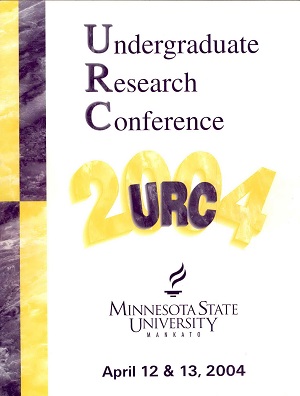Nisin Resistance of Baciluus cerus: Preparation of Nisin
Location
CSU 253/254/255
Start Date
13-4-2004 12:45 PM
End Date
13-4-2004 2:45 PM
Student's Major
Biological Sciences
Student's College
Science, Engineering and Technology
Mentor's Name
Dorothy Wrigley
Mentor's Department
Biological Sciences
Mentor's College
Science, Engineering and Technology
Description
Nisin is a peptide that is made by the bacterium Lactococcus lactis. It is a small molecule that kills gram positive bacteria by binding to their membrane and by disrupting the proton motive force. L. lactis was grown in five different media (BHI, BHI +1% glucose, BHI +1% sucrose, BHI + 3% yeast extract, and skim milk medium). Samples of nisin from these media were filtersterilized and tested for their ability to inhibit the growth of Lactobacillus viridescens, which is susceptible to nisin. It was found that nisin from the media BHI + 3% yeast extract after 8 hours of growth has the same concentration as the standard, which was 1000 mg/ml. The nisin was then purified. An extraction process using ammonium sulfate was used to precipitate nisin out of the media. It was found that a 50% ammonium sulfate concentration precipitated out all of the nisin. The nisin was dialyzed against distilled water to remove the salts. The Minimal Inhibitory Concentration (MIC) of the extracted nisin, using Bacillus cereus and endospores, was equivalent to a commercial nisin preparation at 1000mg/ml.
Nisin Resistance of Baciluus cerus: Preparation of Nisin
CSU 253/254/255
Nisin is a peptide that is made by the bacterium Lactococcus lactis. It is a small molecule that kills gram positive bacteria by binding to their membrane and by disrupting the proton motive force. L. lactis was grown in five different media (BHI, BHI +1% glucose, BHI +1% sucrose, BHI + 3% yeast extract, and skim milk medium). Samples of nisin from these media were filtersterilized and tested for their ability to inhibit the growth of Lactobacillus viridescens, which is susceptible to nisin. It was found that nisin from the media BHI + 3% yeast extract after 8 hours of growth has the same concentration as the standard, which was 1000 mg/ml. The nisin was then purified. An extraction process using ammonium sulfate was used to precipitate nisin out of the media. It was found that a 50% ammonium sulfate concentration precipitated out all of the nisin. The nisin was dialyzed against distilled water to remove the salts. The Minimal Inhibitory Concentration (MIC) of the extracted nisin, using Bacillus cereus and endospores, was equivalent to a commercial nisin preparation at 1000mg/ml.




